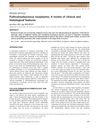Disruption of Tubular Flcn Expression as a Mouse Model for Renal Tumor Induction
June 2015
in “
Kidney International
”
TLDR Disrupting the Flcn gene in mice causes early kidney cysts and tumors, which can be treated with rapamycin.
The study developed a kidney-specific Flcn knockout mouse model to investigate renal tumorigenesis, revealing that Flcn deficiency activated the mTOR and TGF-β pathways, leading to early-onset, high-penetrance renal tumors. The model showed progression from cysts to high-grade renal cell carcinomas (RCCs) and proved valuable for studying kidney cancer mechanisms and testing new drugs. Rapamycin treatment significantly reduced tumor and cyst formation, suggesting its potential as a therapeutic for FLCN-deficient renal tumors. The findings indicated that Flcn deficiency upregulated genes like Mmp2, Mmp14, and Thbs2, contributing to tumor progression through the TGF-β pathway.

